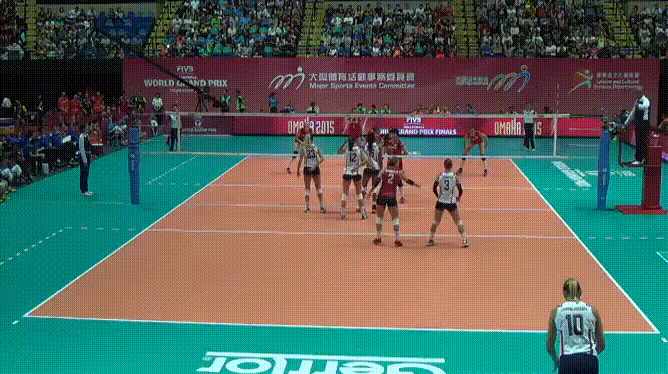Winter Wrap-Up Mailbag Pt2
Quick defense positioning, Float serve rotation, Practice facilities, Developing hands
If you didn’t catch Part 1 of the Winter Wrap-up Mailbag, here it is. (And here’s Part 3)Let’s keep it rolling with Part 2:
Reader Tony Liu asks, in the comment section of 7 ate 9:
What do you think about quick defense has little more depth. 4x2 rather than 2x2 from sideline and 10ft line. Since a lot of balls are killed little deeper in between OH and swings, and those balls are harder to dig. Having depth and letting go of the balls hit closer to lines and make a read when it’s banged into the 2x2 spot.
I like deeper wing defenders as the game is more powerful. So in men's volleyball I like to get those guys a bit deeper. For example:
And what goes hand-in-hand with that is that my lib is also going to be longer and more dynamic and the net is also higher, so tipping is less of a threat. On the flip side, in women's and especially girl's volleyball, tipping is a real threat. For example, we systematically train this scrape tip:
If the lib is at a deep depth, or even a normal depth, this ball is almost impossible to get. The geometry of that play doesn't quite work for high level men's volleyball because the net is too high, the court too small, the guys too long, etc. For boy's volleyball it works well.
So just plan the depth accordingly. But yeah, in theory, "deep as you can be while not getting crushed on tips," is a pretty good way to play.
Or sometimes I also think, "where would you stand if there was no block?" In men's volleyball, you'd have to be suicidal and/or Grebbenikov to want to stand at 3m with a guy bombing a quick on an empty net. If you're comfortable standing there with no block up with your hands down to dig, then that also means you won't have that flinch/backstep reflex in a game and you can either dig from base and then react forward for the tip.
There were a few comments on the Technique TACo Tuesday post. I’ll highlight this one:
Joe, how do you reconcile this straight line approach with the arm swing mechanics from a previous session.. Are you not training hip and shoulder rotation for a float serve?
Let me approach this question broadly:
The younger an athlete is, the more generally I approach everything.
When I mess around and play volleyball (or when we’re inside: Ollyball) with my 4 year-old daughter, I’m not worried about spiking or serving mechanics. At that young age, everything is basically just throwing. Even for kids that are a bit older, I’m not too worried about it; they can serve and spike basically the same way.
At some point a float serve and a topspin spike start to be different. But… you want to keep the core elements of rotational power the same. Good float servers tend to still rotate through the ball to create power, rather than deriving it all from the arm. Servers who are “all arm” tend to muscle the serve and don’t quite have the same touch.
So this reader noticed that my server there didn’t have great rotation mechanics there and she was really linear. That’s not ideal!
Now let’s differentiate though, a server can (and, as I argue in that post, should) take a linear approach while still using rotational hitting mechanics to generate power. Let’s watch the GOAT do it:
(Yes, this clip is almost 10 years old, I don’t care. I believe this is possibly the most perfect float serve ever hit and I will never stop showing it as an example.)
She’s taking a linear approach here. (One thing that’s cool but challenging about watching expert performers is that they tend to blend elements of skills together very quickly, at times making it difficult to see for example purposes. So while my less-advanced servers would land and take a step or two to “stay on the line” she veers almost immediately into her defensive position. Almost. Not that her approach, takeoff, and landing are in basically an exact straight line and she lands and then immediately bounces laterally toward her position. But that change doesn’t happen until after her feet hit the ground.)
So: linear approach. But note that there’s still rotation used to generate power. As much rotation as a max-power spike? No. But rotation nonetheless.
Here’s side-by-sides of the frame before her elbow starts to come forward and the frame as she lands on the ground:
It’s not nearly the almost 180 degree rotation you’ll see from a full-speed spike, but there’s probably 70-90 degrees of rotation in her upper torso, so there’s power generated there.
A college coach asks via email:
We are building/renovating a new volleyball practice facility and wanted sort of video/tech things we could add into that for practices. What sort of technology and video stuff did you guys use with that USA National Team, what other programs are using, or maybe what you guys might be using in Korea. Specifically we were looking at instant replay systems and any other fun toys to add in that could be useful.
My thoughts might be more on design implementation than specific technologies, because I'm sure you guys will find a manufacturer for the specific screens, etc. But...
Keep reading with a 7-day free trial
Subscribe to Smarter Volley by Joe Trinsey to keep reading this post and get 7 days of free access to the full post archives.






